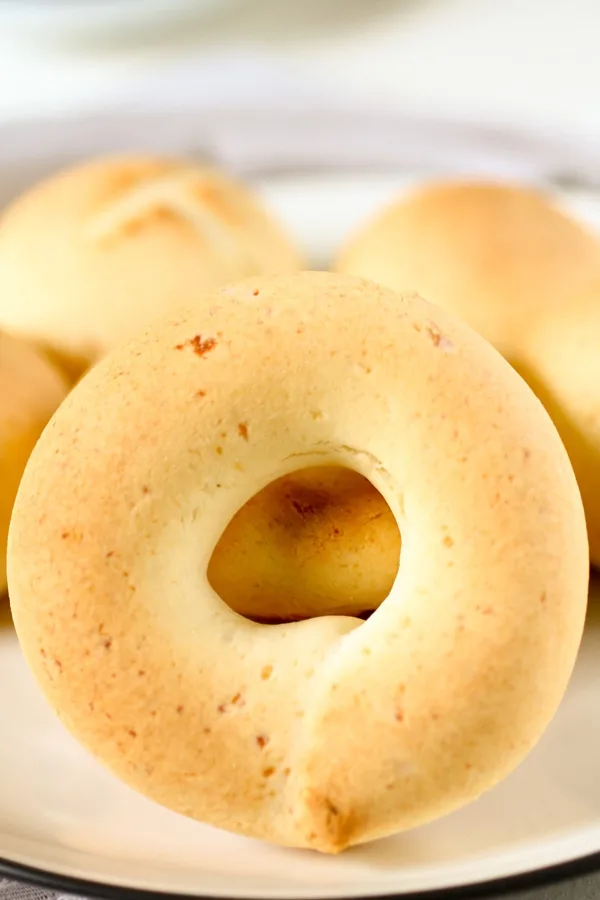
Pandebono is also known as el papá (the father) of starchy bread in Colombia. This small bread has a soft shell and a sticky crumb, with a delicious cheese flavor.
Throughout South America, you’ll find these cheesy rolls (sometimes shaped as a donut) made with cassava starch and cheese, two inexpensive ingredients.
In some countries, cornflour and anise seeds are added as well.
History of Pandebono
There are a few stories of how pandebono (or pan de bono) was first made in Colombia.
However, there are historical records with some validity that suggest it was Genoveva, the midwife-cook of the hacienda el Bono, who, looking to give more nutritional value to the traditional bread, added cassava starch, then corn, and cheese.
This new bread of greater consistency was perfect for the laborers in the hacienda. It was halfway between an appetizer and a meal, capable of holding the men for a longer period of time.
Workers on the hacienda began to share pandebono with other day laborers. It quickly became popular and making it became a source of income for the hacienda owners.
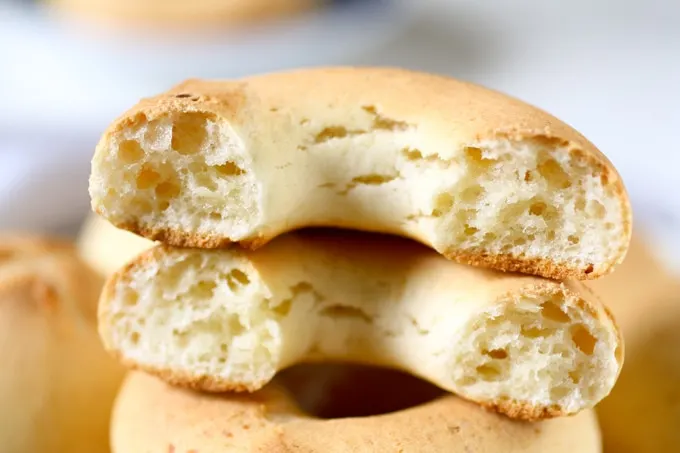
Its particular flavor, sophisticated for the time, soon arrived in the city of Cali, where the recipe was copied and transferred. From there it made its way to the rest of the country and the continent.
The Bono hacienda lost the exclusivity of its production, and the bread gained a regional heritage.
The family (of Persian descent) returned to their original tasks, leaving the production of their precious invention to the world.
The original Colombian cheese bread
These little rolls were initially produced with ground corn, cassava starch, fresh cheese from whole milk, salt, a pinch of sugar, and egg.
They were eaten at any time, often accompanied by coffee or chocolate.
Over time, pandebono reached other cities, selling rapidly in the plazas until it became popular among all bakeries.
Little by little through the years its preparation was modified like its name (from pan del Bono to pandebono) to find new sensations.
Presently, there are 3 main recipes for pandebono. The one we are making today uses precooked cornmeal (like Maseca) along with cassava starch and cheese.
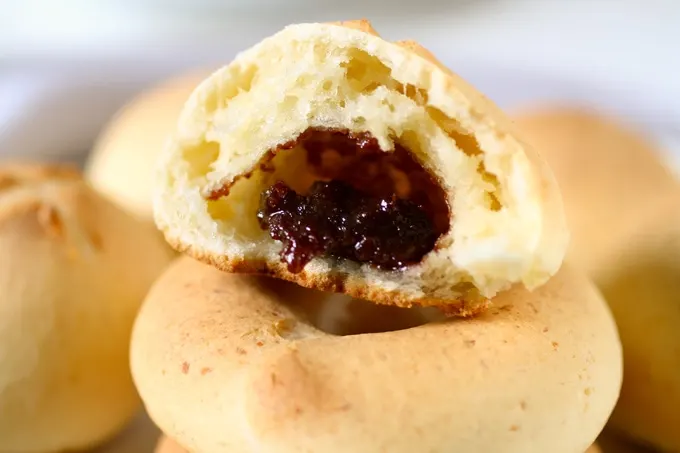
What cheese to use in my pandebono recipe?
The most common cheese used in Colombia to make these rolls is called queso costeño. This cheese is typical of the Caribbean coast. It is characterized by being fresh, white, salty, and soft, although there are harder varieties with more salt.
In the US, many Colombians like to use a mixture of queso fresco and feta cheese, and that is what we are using for this recipe.
Working with cassava starch
Cassava starch absorbs liquid pretty quickly. I recommend you start by mixing cassava starch, cornmeal, cheese, butter, egg, and salt first before adding any milk.
The size of the egg and the amount of liquid in the different brands of fresh cheese will vary, so adding them before adding any milk is very important to check your moisture levels.
After mixing these ingredients, add the milk 1 tablespoon at a time.
You want a soft dough that stays together when you press it between your hands.
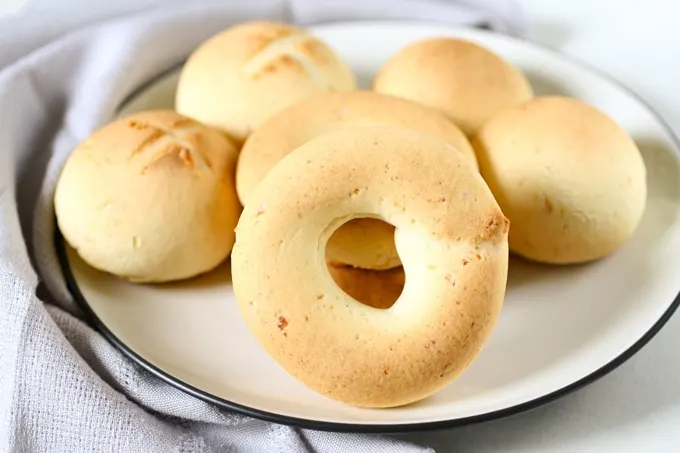
Shaping the dough and baking the cheese bread
After dividing the dough into 15 equal portions, shape them into balls or little donuts.
Some people like adding a small piece of guava paste to some of their pandebono before baking and making a cross or some lines on top of the bread to let people know they are filled. (The combination of fruit paste and cheese is a common one across South America. For example, you will find it in these Brazilian appetizers and in these Argentinian cheese empanadas.)
Pandebonos are best eaten the same day they are baked. They become hard the next day. However, they can be reheated in an oven or toaster oven at 350F for around 10 minutes (watch them so they don’t burn).
(And if you like the sound of this bread, you’ll want to take a look at our other Colombian recipes too!)
Pandebono (Colombian Cassava Bread)
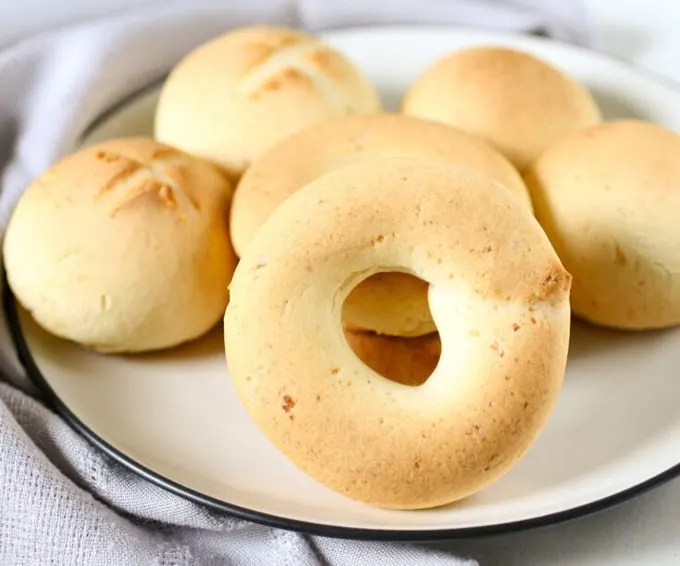
Pandebono (or pan de bono) is a Colombian cheese bread made with cassava starch. This gluten free cheese bread is often eaten for breakfast or as a snack.
Ingredients
- 2 cups cassava flour
- 1/4 cup corn flour (masa)
- 2 Tbsp sugar
- 1 tsp baking powder
- 2 cups (10 oz) queso fresco, shredded
- 1/2 cup (2 oz) feta cheese, finely crumbled
- 1 1/2 tsp salt (less if your cheese is salty)*
- 1 egg
- 2 Tbsp butter, softened to room temperature
- 5 Tbsp milk (more as needed)**
- Guava paste, if desired
Instructions
- Preheat oven to 420F and grease a baking sheet.
- In a big bowl, add cassava flour, corn flour (masa), sugar, baking powder, and cheeses. Mix to combine.
- Taste your mixture and add salt as needed.* Mix to distribute the salt.
- Add the egg, and butter. Mix well using the tips of your fingers.
- Add 4 tablespoons of milk, one at a time, mixing until the dough comes together. If the dough crumbles when you make a little ball, it needs more milk. Add more milk, one tablespoon at a time, until the dough comes together and doesn't crumble when you form a ball.**
- Divide the dough into 16 portions, roll each one into a ball and place on the prepared baking sheet. Bake for 17-20 minutes, until golden.
- To make filled pandebono: Make a ball with the dough and press with your thumb making a little well in the center. Add a small cube (1 inch) of guava paste and bring the dough together covering the paste, pinching the seam to seal. Shape into a ball again and place on the baking sheet and bake 17-20 minutes, until golden.
- To make a pandebono ring: Roll each ball by hand in to a 6-inch rope. Bring the two edges together to form a circle. Press to seal well. Place on the baking sheet and bake 15-17 minutes, until golden.
- Pandebono is best eaten fresh out of the oven (as soon as it is cool enough to handle) or while still warm. (Reheat any leftover pandebono in an oven or toaster oven set at 350F for around 10 minutes, keeping an eye on them so they don't burn.)
Notes
*Taste your cheese before making this bread. If your cheese is salty, decrease the salt to taste. If you make any substitutions to the cheese, you will need to alter the salt amount accordingly.
**The amount of milk needed for this recipe depends on the type of cheese used (and the size of your egg). Don't be afraid to continue adding milk, one tablespoon at a time and mixing between additions, until the dough does not crumble when you shape it into a ball.
Recommended Products
As an Amazon Associate and member of other affiliate programs, We earn from qualifying purchases.
Nutrition Information:
Yield:
16Serving Size:
1 pandebonoAmount Per Serving: Calories: 86
If you liked this recipe, here are some similar dishes you may enjoy!

Lizet is Bolivian and lives in Paraguay. Through friends and travel she has developed her love of food. From Africa to Asia, Europe to the Americas, there is always something new to try when you come to dinner. You can find more of Lizet’s tasty creations on her website ChipaByTheDozen.com. You can also find her on Instagram and Facebook.




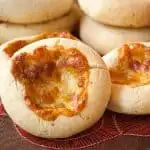

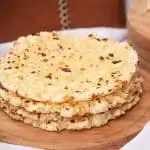




Carolina
Monday 12th of February 2024
Thank you so much for sharing this recipe. It made me incredibly happy to have the taste from home. The recipe is perfect
Sarah - Curious Cuisiniere
Tuesday 13th of February 2024
We're so glad you enjoyed the recipe!
Tom M
Friday 11th of November 2022
After trying this recipe, these came out good. The texture of the bread did not come out as expected. The texture was grainy and not smooth. Does this mean I did not use enough milk?
Marie
Saturday 17th of December 2022
@Tom M, I had the same issue. The inside of the Pandebono was the perfect taste and texture but there was a slight graininess in the crust. I used Bob’s Red Mill brand tapioca flour.
Sarah - Curious Cuisiniere
Monday 14th of November 2022
HI Tom. If the texture was grainy, it is likely that your cassava flour or corn flour was too coarse of a grind.
Olga Gonzalez
Tuesday 28th of September 2021
Thank you! I'm Colombian but had no idea of its origin. Missing food from home and your recipe is awesome!
Sarah Ozimek
Thursday 30th of September 2021
So glad you enjoyed it!
Angelica Maria Baeza
Thursday 23rd of September 2021
Best pandebono recipe I've tried yet!! That list is extensive, fyi! Thank you sooo much!! Great job!
Sarah Ozimek
Saturday 25th of September 2021
So glad you enjoyed them!